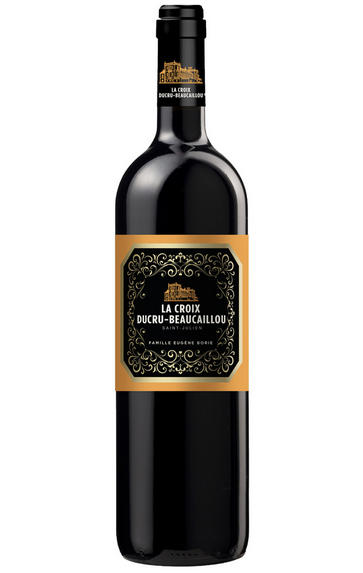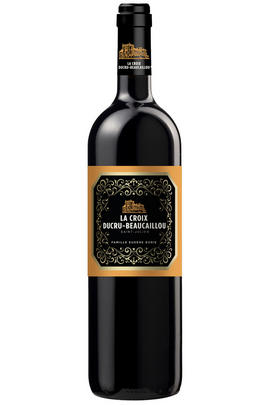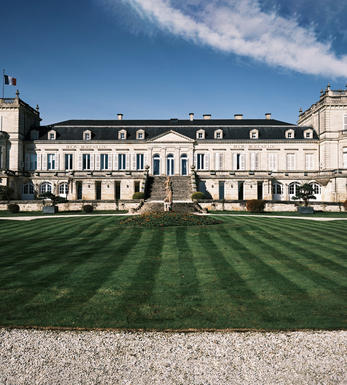
2022 La Croix Ducru-Beaucaillou, St Julien, Bordeaux

Critics reviews
The 2022 La Croix Ducru-Beaucaillou contains much more Merlot this year as they compensated for the lack of Cabernet Sauvignon; this Deuxième Vin is raised in 80% new oak. It has a delineated bouquet with a mixture of red and black fruit. The briary and smoky aromas feel more understated compared to its peers.
The palate is medium-bodied with fine tannins and seamlessly integrated oak that lends a silky texture. Very harmonious with an insistent grip (the IPT is 93), it lacquers the mouth long after it has departed. That Pauillac tincture is displayed and defines its precise finish.
Excellent, but be warned that the oak will require several years to assimilate fully. Not so far behind the Grand Vin because of the growing season.
Drink 2030 - 2058
Neal Martin, Vinous.com (April 2023)
The 2022 La Croix Ducru-Beaucaillou is super-expressive. The aromatics and tannin show strong Cabernet Sauvignon inflexions, but the blend actually favours Merlot in this vintage, as yields in the Cabernet were on the low side. This serious, potent Saint-Julien will need some time to come together fully, but it is certainly impressive.
Drink 2025 - 2042
Antonio Galloni, Vinous.com (April 2023)
Sculpted with muscular tannins, it keeps things strictly controlled on the opening beats, then opens to show creamy damson and blackberry fruits, grilled vanilla bean, peony, iris, bitter chocolate, lifted aromatics of peony and crushed rose petals, and clear salinity on the finish.
This is intense and impressive, aged in 80% new oak. Harvest September 7 to October 4, almost an entire month of harvesting, unusual for the vintage. Tasted twice.
Drink 2028 - 2042
Jane Anson, JaneAnson.com (May 2023)
The 2022 La Croix de Beaucaillou opens in the glass with aromas of dark berries, cigar wrapper and fresh mint, framed by creamy new oak. Medium to full-bodied, rich and fleshy, with a deep core of fruit framed by chunky tannins, it blends 66% Merlot, 32% Cabernet Sauvignon and 2% Petit Verdot.
William Kelley, Wine Advocate (April 2023)
66% Merlot, 32% Cabernet Sauvignon, 2% Petit Verdot. Cask sample.
Restrained aromatically with just a touch of vanilla oak. Bright, fresh and smooth on the palate with a saline note on the finish. Bit of chew at the end. Potential but needs to settle. Quite a lot of new oak (80%) needs to be absorbed.
Drink 2030 - 2040
James Lawther MW, JancisRobinson.com (May 2023)
A chewy and polished red with blackberry and blueberry character. Full to medium body. Fine and tensioned. Excellent finish. Salty. Blackcurrants at the end. 66% merlot, 32% cabernet sauvignon, and 2% petit verdot.
James Suckling, JamesSuckling.com (April 2023)
Bramble tones; fragrant and rich blackberry notes on the nose. A dark soul with depth and intensity, this has such richness and power but restraint also. Concentrated with a directness and focus that drives it from start to finish, aided by a linear vein of salinity, liquorice and blackcurrant.
The tannins are robust and grippy, giving an impressive structure that is imposing in the mouth but retains a suave and endearing quality. Such charm and potential.
Drink 2027 - 2045
Georgina Hindle, Decanter.com (April 2023)
The second wine of this great château, the 2022 La Croix Ducru-Beaucaillou, is based on two-thirds Merlot, with the balance mostly Cabernet Sauvignon, raised in 80% new French oak. Hitting 14% natural alcohol, its vivid purple hue is followed by stunning aromatics of cassis, blueberries, tobacco, graphite, and chalky minerality.
Full-bodied on the palate, it brings plenty of concentration and structure yet is balanced and has a great mid-palate and outstanding length. If there was a ranking for the top second wines in Bordeaux, this would be in the top handful of releases.
Jeb Dunnuck, JebDunnuck.com (May 2023)
About this WINE

Chateau Ducru-Beaucaillou
Château Ducru-Beaucaillou is a St-Julien property that today is one of the leading Super Seconds. It is owned by the Borie family and is situated in the south-east of the St-Julien appellation. Ducru-Beaucaillou's 50 hectares of vineyards (Cabernet Sauvignon 65%, Merlot 25%, Cabernet Franc 5% and Petit Verdot 5%) lie on deep, large-stone gravel beds enriched with alluvial soil deposits and with a high clay content. The wines are matured in oak barriques (50-60% new) for 18 months.
For many, Ducru-Beaucaillou is the quintessential St-Julien - deep-coloured, powerful, ripe, exquisitely well-balanced and perfectly harmonious. It requires a minimum of 10 years of bottle ageing before it should be approached and the best vintages will continue improving for many more years. Ducru-Beaucaillou is classified as a 2ème Cru Classé.

St Julien
St Julien is the smallest of the "Big Four" Médoc communes. Although, without any First Growths, St Julien is recognised to be the most consistent of the main communes, with several châteaux turning out impressive wines year after year.
St Julien itself is much more of a village than Pauillac and almost all of the notable properties lie to its south. Its most northerly château is Ch. Léoville Las Cases (whose vineyards actually adjoin those of Latour in Pauillac) but, further south, suitable vineyard land gives way to arable farming and livestock until the Margaux appellation is reached.
The soil is gravelly and finer than that of Pauillac, and without the iron content which gives Pauillac its stature. The homogeneous soils in the vineyards (which extend over a relatively small area of just over 700 hectares) give the commune a unified character.
The wines can be assessed as much by texture as flavour, and there is a sleek, wholesome character to the best. Elegance, harmony and perfect balance and weight, with hints of cassis and cedar, are what epitomise classic St Julien wines. At their very best they combine Margaux’s elegance and refinement with Pauillac’s power and substance.
Ch. Léoville Las Cases produces arguably the most sought-after St Julien, and in any reassessment of the 1855 Classification it would almost certainly warrant being elevated to First Growth status.
Recommended Châteaux: Ch. Léoville Las Cases, Ch.Léoville Barton, Ch Léoville Poyferré, Ch. Ducru-Beaucaillou, Ch Langoa Barton, Ch Gruaud Larose, Ch. Branaire-Ducru, Ch. Beychevelle

Cabernet Sauvignon Blend
Cabernet Sauvignon lends itself particularly well in blends with Merlot. This is actually the archetypal Bordeaux blend, though in different proportions in the sub-regions and sometimes topped up with Cabernet Franc, Malbec, and Petit Verdot.
In the Médoc and Graves the percentage of Cabernet Sauvignon in the blend can range from 95% (Mouton-Rothschild) to as low as 40%. It is particularly suited to the dry, warm, free- draining, gravel-rich soils and is responsible for the redolent cassis characteristics as well as the depth of colour, tannic structure and pronounced acidity of Médoc wines. However 100% Cabernet Sauvignon wines can be slightly hollow-tasting in the middle palate and Merlot with its generous, fleshy fruit flavours acts as a perfect foil by filling in this cavity.
In St-Emilion and Pomerol, the blends are Merlot dominated as Cabernet Sauvignon can struggle to ripen there - when it is included, it adds structure and body to the wine. Sassicaia is the most famous Bordeaux blend in Italy and has spawned many imitations, whereby the blend is now firmly established in the New World and particularly in California and Australia.


Buying options
Add to wishlist
Description
Merlot dominates this year due to the reduced volumes of Cabernet Sauvignon. The fruit comes from the heart of the appellation and a parcel to the south of the Mouline stream, though a plot or two from the grand vin can be incorporated.
The essence of the vintage is captured in the alluring nose of warming cumin, cinnamon spice, and potpourri rose. This is exceptionally smooth and silky. Ageing is in 80% new oak; the oak tannins should add some sapidity to the final wine. This is a very seductive wine, very carefully groomed.
Merlot 66%; Cabernet Sauvignon 32%; Petit Verdot 2%.
Drink 2028 - 2042
Score: 16.5/20
Berry Bros. & Rudd (April 2023)
wine at a glance
Delivery and quality guarantee